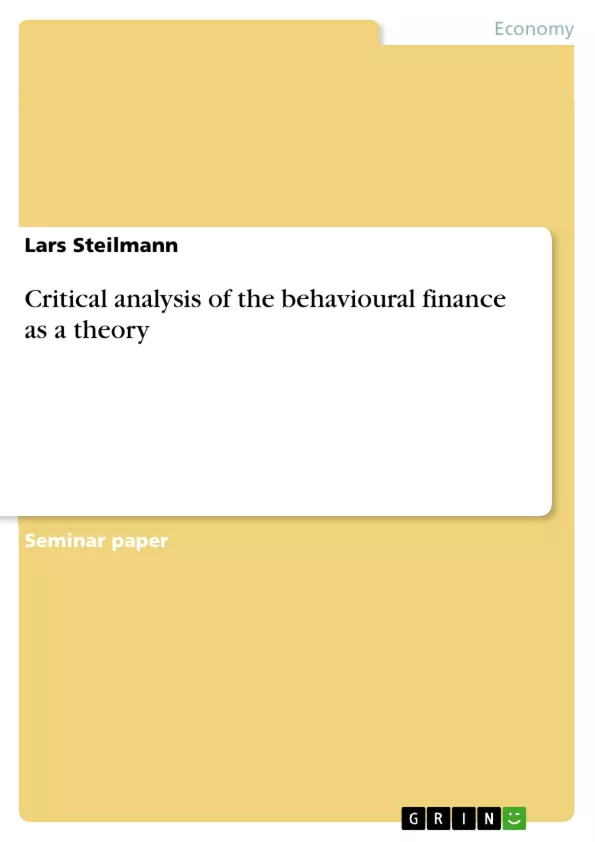The process of making decisions on the financial market is influenced by various factors and involves a relatively complex behaviour. In general two factors drive the process, one the financial model, that represents the correlation of risk and return and second the internal factors determined by skill level, investment portfolio and education. This work at hand distinguishes between traditional and modern theory of financial markets. The Efficient Market Hypothesis (EMH) explains that investors act rationally and make economic decisions on a rational basis. These process of decision making is explained in the Expected Utility Theory and assumes that investors are doing everything to optimize their performances, which correlates with the term `homo oeconomicus`. The behavioural financial theory, taken as the modern theory, basically handles individual circumstances that result in decision makings on the market.
This work at hand will work out the changes that proceeded over the years and try to explain which way is more sufficient for analysing and understanding occasions on the financial market. The aim is to impart, how behavioural finance tries to explain the financial market with help of models. Furthermore possible shortcoming or critics of these models shall be shown.
Inhaltsverzeichnis (Table of Contents)
- 1. Introduction
- 1.1. Problem description
- 1.2. Structure and boundaries
- 2. Modern and Traditional Finance Theory
- 2.1. Basic Classification
- 2.2. Emergence of Behavioural Finance
- 2.3. Anomalies on financial markets
- 3. Factors of Behavioural Finance
- 3.1. Overconfidence
- 3.2. Prospect Theory
- 3.3. Heuristics
- 3.4. Comfort of Crowds
- 4. Criticism of Behavioural Finance
- 5. Conclusion
Zielsetzung und Themenschwerpunkte (Objectives and Key Themes)
This work aims to provide a comprehensive analysis of behavioural finance as a theory, contrasting it with traditional finance theory. It explores the historical emergence of behavioural finance, its core concepts, and its implications for understanding financial market behaviour. The primary objective is to demonstrate how behavioural finance offers an alternative perspective on market dynamics, particularly in explaining deviations from the predictions of traditional, rational models.
- The evolution and development of behavioural finance
- Key behavioural factors influencing decision-making in financial markets
- The strengths and limitations of behavioural finance as a theoretical framework
- Contrasting behavioural finance with traditional finance theory
- Applications and implications of behavioural finance for market analysis
Zusammenfassung der Kapitel (Chapter Summaries)
- Chapter 1: Introduction: This chapter introduces the concept of behavioural finance, highlighting the complex decision-making processes within financial markets. It outlines the key differences between traditional and modern finance theories, setting the stage for the subsequent exploration of behavioural finance principles.
- Chapter 2: Modern and Traditional Finance Theory: This chapter provides a detailed analysis of traditional finance theory, focusing on the Efficient Market Hypothesis (EMH) and its core assumptions of rational decision-making. It then explores the emergence of behavioural finance, examining the challenges it presents to traditional models and highlighting the increasing significance of psychological and behavioural factors in market analysis.
- Chapter 3: Factors of Behavioural Finance: This chapter delves into the key behavioural factors that influence decision-making in financial markets. It explores concepts like overconfidence, prospect theory, heuristics, and the "comfort of crowds," demonstrating how these factors contribute to deviations from traditional models.
- Chapter 4: Criticism of Behavioural Finance: This chapter examines the critical perspectives on behavioural finance, discussing its potential shortcomings and limitations. It evaluates the strengths and weaknesses of both modern and traditional financial theories in explaining market phenomena.
Schlüsselwörter (Keywords)
The primary keywords and themes in this work encompass traditional finance theory, efficient market hypothesis, behavioural finance, prospect theory, heuristics, overconfidence, market anomalies, decision-making, and the interplay between psychology and economics in understanding financial market dynamics.
- Arbeit zitieren
- Lars Steilmann (Autor:in), 2015, Critical analysis of the behavioural finance as a theory, München, GRIN Verlag, https://www.grin.com/document/378168



